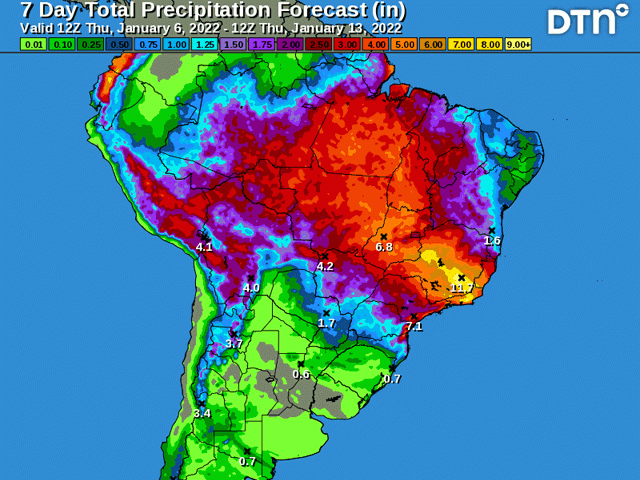South America Calling
Broken-Record Forecast Not Helpful in South America
Another week goes by and yet another forecast for wetness continues in central and northern Brazil along with dryness for Argentina and southern Brazil. There has been very little change in this dichotomy during the last 60 days or so. Sure, every once in a while we get a good system or couple of systems in a week that brings at least some showers across the southern half of the continent's main growing regions. But the overall theme has been maintained as La Nina conditions have stabilized across the equatorial Pacific Ocean.
At first, we were only concerned about the southern half of South America. Attention there has long been focused on the dryness and heat sometimes soaring up to 40 Celsius (100 to 104 Fahrenheit) affecting planting in Argentina, development and reproduction in southern Brazil, and the concern about later-planted and second crops (safrinha) planted in bone-dry topsoils with limited subsoil moisture to boot.
But as I wrote last week (https://www.dtnpf.com/…), wetness across the north is also causing some issues. That is especially true now that first-crop soybeans are maturing and harvest has begun. Aside from the wetness causing concerns about grain quality, delays to harvest and the subsequent planting of safrinha corn produces a risk for markets. With harvest delays, soybeans may not be available to world markets when first expected based on early planting dates, and importers may have to turn elsewhere if they cannot wait the extra time.
P[L1] D[0x0] M[300x250] OOP[F] ADUNIT[] T[]
But the larger risk is to the safrinha corn crop and the eventual end of the wet season. Typically, the end of the wet season comes at the beginning of May, when corn has ended or is nearing the end of pollination and can survive on ample subsoil moisture for grain-fill.
But La Nina has a tendency to cut the wet season short. Last year, rains ended about four-to-five weeks early and late-planted corn had tough weather conditions to survive as rains shut down well before pollination for most places.
The fear for Brazilian producers this year is that any delays in planting of safrinha corn could be combined again with a shortened wet season and eventual moisture stress late in the season. It would be tough to see the wet season stopped short by a full month, like last year, and models are not currently giving any hints that would be the case. But that is still about four months out, so anything is still possible. There is a long way yet to go.
Back to the broken-record of a forecast, there is no significant change in the next 10 days at least for the wet-north and hot-and-dry-south pattern. Some isolated showers during the past week have produced a little bit of rainfall for some areas of Argentina and southern Brazil, but for the most part, it was inadequate for crops, mostly falling with 15 millimeters (about 0.60 inches) or less for the week.
The one bright spot was in the state of Parana, which saw some more meaningful showers during the last seven days. Reports of over 50 mm (about 2 inches) were made in key portions of the state's growing region. But rainfall may have come too late. Much of the corn and soybean crop has been affected by the ongoing drought and is in the reproductive and fill stages. Some early harvest has started up as well. Drought damage has already been done. Like the Northern Plains of the U.S. this past year, the rains likely have some stabilizing effect, and production in the state could end up better than feared it will be. But crop conditions have been on the decline for the last several weeks.
Parana also stands a better chance to get in on the scattered showers over central and northern portions of the country during the next week as well. Previously left out of that pattern, the turn could have some limited impact on the current crop, and potentially improve soil conditions for safrinha corn. The state of Parana usually produces about 16% of Brazil's corn and soybean production. So, the effect is not insignificant. But the rest of South America is in line for what we have been witnessing this year, and that is not a good pattern on the whole for South American producers.
John Baranick can be reached at john.baranick@dtn.com
(c) Copyright 2022 DTN, LLC. All rights reserved.




